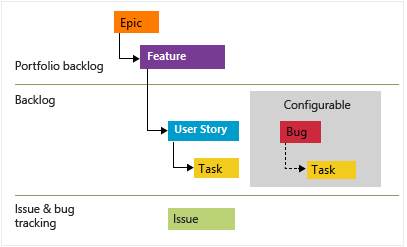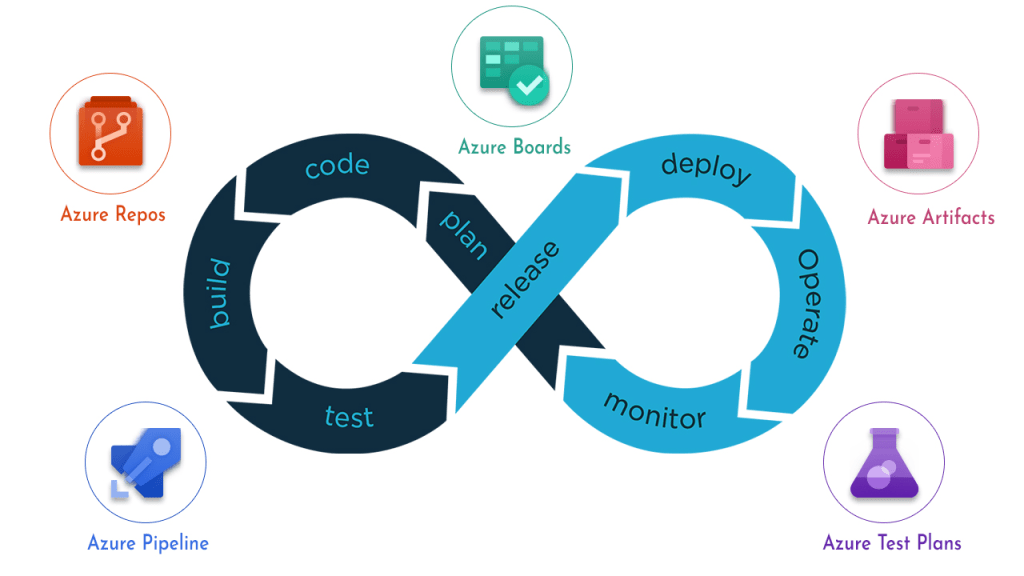
- Introduction to Azure Boards
- Key Features of Azure Boards
- Setting Up and Configuring Azure Boards
- Creating and Managing Work Items
- Boards, Backlogs, and Sprints in Azure Boards
- Integrating Azure Boards with DevOps Pipelines
- Customizing Azure Boards for Agile and Scrum Teams
- Best Practices for Using Azure Boards Efficiently
- Reporting and Analytics in Azure Boards
- Conclusion
Introduction to Azure Boards
Azure Boards is a comprehensive work tracking system Microsoft provides within its Azure DevOps suite. It allows teams to manage projects, track work items, plan sprints, and collaborate effectively across the development lifecycle. Azure Boards is designed to help teams manage software development in a more structured, organized, and transparent way. It integrates well with other Azure DevOps services, such as Azure Repos, Azure Pipelines, and Azure Test Plans, providing a unified environment for DevOps teams, a key concept covered in Microsoft Azure Training. Azure Boards supports various methodologies, including Agile, Scrum, and Kanban, making it suitable for diverse development workflows. It provides features such as backlogs, boards, work item tracking, reporting, and dashboards that help teams efficiently organize, monitor, and control their work. This article will explore Azure Boards’ key features, how to set it up and configure it, and best practices for using it effectively in Agile and Scrum environments. We’ll also cover integration with DevOps pipelines, security features, and future trends in Azure Boards.
To Earn Your Azure Certification, Gain Insights From Leading Azure Experts And Advance Your Career With ACTE’s Azure Training Today!
Key Features of Azure Boards
Azure Boards offers a variety of features that support work item tracking, team collaboration, and agile project management. Some of the key features include:
- Work Item Tracking: Azure Boards tracks various work items, including user stories, tasks, bugs, and issues. Work items are the core of project tracking and can be customized to reflect your team’s workflows. Azure Boards offers rich fields for each work item, such as priority, assignee, state, and iteration, which can be customized to meet the team’s needs.
- Kanban Boards: The Kanban board in Azure Boards allows teams to visualize and manage work in progress. It provides a clear view of tasks, their states, and the workflow across columns. With drag-and-drop functionality, teams can quickly move work items through the stages of their workflow, ensuring smooth task management.
- Backlogs: Azure Boards offers customizable backlogs that give teams an overview of their work items, tasks, and user stories, while Azure Active Directory provides secure identity and access management to ensure proper permissions and access control within the platform. With a clear visual hierarchy, teams can prioritize work, plan sprints, and track progress. Backlogs also offer features like drag-and-drop prioritization, allowing easy reordering of tasks.
- Sprints and Iterations: Azure Boards supports sprint planning and tracking, helping teams define time-boxed iterations for completing work. You can set up sprint schedules, define sprint goals, and track team progress using burndown charts and other metrics.
- Dashboards: Dashboards in Azure Boards allow users to display essential data in a customizable, graphical format. You can create dashboards that provide an overview of key metrics, including work item status, team progress, and issue tracking. This is an excellent tool for managers and stakeholders to track real-time project progress.
- Reporting and Analytics: Azure Boards integrates with Azure DevOps Analytics to offer in-depth reporting and analytics. Teams can generate various reports, such as sprint burndown charts, velocity charts, and cumulative flow diagrams. This helps teams measure productivity, identify bottlenecks, and make data-driven decisions.
- Navigate to Azure DevOps and sign in with your Microsoft account.
- Select New Project and fill in the details (project name, visibility, and version control options).
- After creation, you’ll be redirected to your project dashboard to access Azure Boards.
- Go to Project Settings > Process and select the appropriate template for your team.
- Customize the work item types and workflows as needed.
- Go to Project Settings > Teams to configure your teams.
- Assign team members and define their roles based on their responsibilities.
- Set up Backlogs to reflect user stories, tasks, and bugs.
- Set up Sprints to organize work into manageable iterations, assign tasks, and track progress over time.
- Customize your Kanban Board by adding columns, setting work-in-progress limits, and defining workflows.
- Boards: The backlog provides an overview of all the work items assigned to the team. Azure Boards allows you to prioritize work items and break them down into smaller tasks, a process thoroughly covered in Microsoft Azure Training. You can reorder backlog items with a simple drag-and-drop interface. This is especially useful for planning sprints and managing scope.
- Backlogs: The Kanban board is a visual tool for showing the flow of work. It can be customized with different columns to represent stages of your workflow (e.g., Backlog, To Do, In Progress, and done). The board allows you to drag and drop work items to reflect their current state, which helps team members easily see what needs to be done.
- Sprints: The sprint planning feature enables teams to break down work into time-boxed iterations. You can assign tasks to sprints, set deadlines, and track progress via burndown charts.
- Customizing Work Item Types: You can create custom work item types or modify existing types to reflect your team’s specific terms and processes, a practice that can be enhanced with a solid understanding of a Basic Guide to Computer Networks to optimize communication and collaboration across systems. For example, you may need to add custom fields, change the workflow states, or configure custom rules.
- Adjusting Board Layouts: Azure Boards allows teams to customize the board layout to reflect their unique workflow. Teams can add columns for each stage of work, configure work-in-progress limits, and ensure that the board reflects the actual work process.
- Agile and Scrum Reporting: Azure Boards include built-in reports such as burndown charts, sprint velocity, and cumulative flow diagrams, essential for Agile and Scrum teams. These reports can be customized based on the team’s workflow and goals.
- Burndown Charts: Tracks the work completed over time within a sprint.
- Velocity Charts: Measures the amount of work the team completes during a sprint.
- Cumulative Flow Diagram: Displays work item progress over time.
- Lead Time and Cycle Time Reports: Helps teams measure the time taken from the start of a work item to its completion, identifying potential delays in the process.
- Work Item Trend Reports: Provides insights into how the number of work items changes over time, helping to identify trends in workload and task completion.
- Release Burndown: Displays progress toward completing the remaining work for a release, giving teams visibility into whether they are on track to meet release goals.

Setting Up and Configuring Azure Boards
Setting up and configuring Azure Boards is straightforward, especially when integrated with Azure DevOps. Below are the steps to get started:
Create a Project in Azure DevOps
First, you need to create a project within Azure DevOps. This container is for all DevOps activities, including boards, reports, pipelines, etc.
Configure Process Template
The process template defines how work is tracked within Azure Boards. You can select from Agile, Scrum, or CMMI (Capability Maturity Model Integration) templates, while Simplify Azure Management Using Resource Groups helps organize and manage resources efficiently for better project tracking and coordination. These templates represent the work items available (e.g., user stories, tasks) and the workflow stages (e.g., To Do, In Progress, Done).
Create Teams and Set Permissions
Once your project is created, you can set up different teams for more granular control over work items and permissions. You can assign users to other teams, such as development, QA, or operations, and provide them with the necessary access levels (read, contribute, or manage).
Configure Boards, Backlogs, and Sprints
Azure Boards comes pre configured with boards and backlogs, but you can adjust these to match your team’s workflow.
Excited in Learning More About Azure? Sign Up For Our Azure Training Today!
Creating and Managing Work Items
Work items in Azure Boards are essential for tracking tasks, bugs, and user stories, and managing them is both easy and customizable. Each work item represents a task that needs to be completed and can be assigned to individuals, prioritized, and tracked. There are several types of work items: Epic, which is a large body of work that can be broken down into smaller user stories; Feature, which is a significant functionality contributing to the completion of an epic; User Story, which is a small, functional work providing value to the end user; Task, which refers to a technical or operational activity required to complete a user story; and Bug, which is a defect or issue that needs to be resolved, all of which can be managed effectively in the context of DevOps vs DevSecOps to ensure both development speed and security in the software lifecycle. To create a work item, open the Boards tab, select Work Items, and click New Work Item. From there, choose the work item type (e.g., user story or bug) and fill in details such as title, description, priority, and assignee. You can also customize workflow states, such as To Do, In Progress, or Done, based on your team’s processes. It’s also possible to link related work items for better traceability (e.g., linking tasks to user stories or bugs to features). Azure Boards provides powerful filtering and querying capabilities, allowing you to filter work items by assignee, state, priority, or sprint. Additionally, custom queries can be created, saved, and shared with the team, ensuring everyone stays on the same page.
Boards, Backlogs, and Sprints in Azure Boards
Azure Boards provides robust tools for organizing and tracking work at different levels, such as the team, sprint, or project level.
Integrating Azure Boards with DevOps Pipelines
Azure Boards integrates seamlessly with Azure Pipelines to automate continuous integration (CI) and continuous delivery (CD) workflows, enabling you to track work status and deployments directly from the board by linking work items to pipeline runs in Azure Pipelines. To integrate, navigate to Boards in Azure DevOps, open the work item you want to link, and in the work item, select the Development tab and click “Link to an Existing Pipeline.” This links the work item to the pipeline, providing visibility into deployment and build status directly from the Azure Boards interface, which is an essential part of Exploring the Cloud-First Strategy to streamline workflows and accelerate cloud adoption. This integration ensures that the work tracked in Azure Boards is directly aligned with CI/CD processes in Azure Pipelines, streamlining development and deployment workflows. Furthermore, it improves collaboration between development and operations teams by offering real-time insights into build failures or successes. This connection also enables automated updates to the work item status based on pipeline results, ensuring everyone stays informed.

Additionally, linking work items to pipeline runs allows for better traceability and easier identification of issues or bottlenecks in the deployment process. The integration ultimately enhances team productivity by minimizing manual tracking efforts and improving the accuracy of project progress. As a result, teams can deliver high-quality software faster and more efficiently.
Looking to Master Cloud Computing? Discover the Cloud Computing Masters Course Available at ACTE Now!
Customizing Azure Boards for Agile and Scrum Teams
Azure Boards is highly customizable, making it an excellent tool for both Agile and Scrum teams. Whether you follow Scrum’s sprint-based methodology or prefer Kanban’s continuous flow model, Azure Boards can be tailored to your needs.
Best Practices for Using Azure Boards Efficiently
To use Azure Boards efficiently, it’s essential to ensure that your workflow states align with your team’s processes. Standardizing workflows across teams enhances overall efficiency. Automating tasks like assigning work items or updating statuses can save valuable time, while creating templates for everyday work items or processes helps streamline setup and reduce repetitive work. Regularly reviewing and prioritizing your backlog ensures that the team focuses on the most critical tasks, and using Azure Boards’ priority fields helps clearly mark high-priority tasks for focus. Additionally, tracking work item progress through visual reports and dashboards helps quickly identify and address any potential blockers. Encouraging team members to comment on and link related work items fosters open communication and alignment on goals, which is essential in understanding different Cloud Computing Models and how they support collaboration and efficiency. It’s also beneficial to periodically assess workflows and adjust them based on evolving team needs or new insights to maintain optimal efficiency. In terms of security, Azure Boards utilizes role-based access control (RBAC) to define who can view or modify work items, ensuring that only the right individuals have access to sensitive data. This granular control promotes a secure work environment and simplifies the management of team access as project needs evolve, ensuring compliance and reducing risks. With RBAC, access can be customized for individual projects, boards, or even specific work items, offering flexibility and control over sensitive information. Looking ahead, Azure Boards will continue to evolve by focusing on improved automation, integration with more third-party tools, and enhanced reporting features. The platform will also offer enhanced customization options, allowing users to tailor workflows more efficiently.
Want to prepare for Azure Job Interviews? Have a Look at Our Blog on Azure Interview Questions And Answers To Ace Your Interview!
Reporting and Analytics in Azure Boards
Azure Boards integrates with Azure DevOps Analytics to provide rich reporting capabilities. Some of the key reports include:
These reports allow teams to gain valuable insights into their workflow, identify bottlenecks, and make data-driven decisions to optimize performance and improve efficiency, a key skill developed through Microsoft Azure Training.
Conclusion
Azure Boards is a robust and versatile tool that streamlines work tracking and enhances collaboration for DevOps teams. With its rich set of features, including work item tracking, customizable boards, backlogs, sprints, and detailed reporting, it enables teams to efficiently manage their workflows, regardless of whether they follow Agile, Scrum, or Kanban methodologies. The seamless integration with other Azure DevOps services and pipelines ensures smooth collaboration across the software development lifecycle. By offering customizable workflows, collaboration features, and powerful reporting and analytics, Azure Boards empowers teams to make data-driven decisions and continuously improve their processes. Additionally, its focus on security and role-based access control ensures that sensitive data remains secure while facilitating smooth team collaboration. Looking to the future, Azure Boards is set to evolve even further with enhanced automation, third-party integrations, and AI-driven insights, helping teams stay agile and productive in an ever-changing development environment. Whether you’re managing small projects or large-scale initiatives, Azure Boards is a critical tool for driving success in DevOps and software development.





